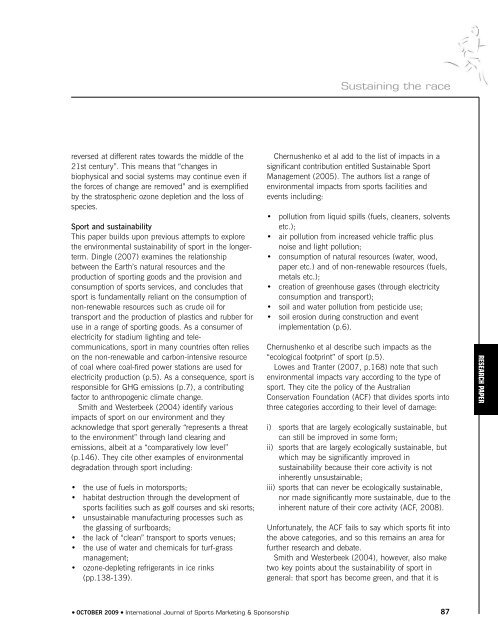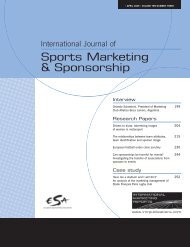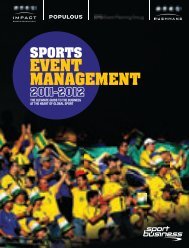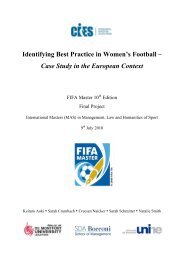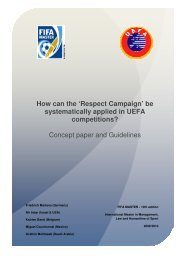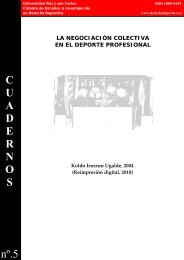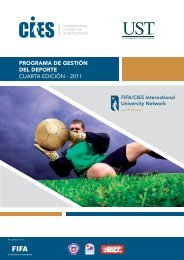Sports Marketing & Sponsorship - FIFA/CIES International University ...
Sports Marketing & Sponsorship - FIFA/CIES International University ...
Sports Marketing & Sponsorship - FIFA/CIES International University ...
- No tags were found...
You also want an ePaper? Increase the reach of your titles
YUMPU automatically turns print PDFs into web optimized ePapers that Google loves.
Sustaining the racereversed at different rates towards the middle of the21st century”. This means that “changes inbiophysical and social systems may continue even ifthe forces of change are removed” and is exemplifiedby the stratospheric ozone depletion and the loss ofspecies.Sport and sustainabilityThis paper builds upon previous attempts to explorethe environmental sustainability of sport in the longerterm.Dingle (2007) examines the relationshipbetween the Earth’s natural resources and theproduction of sporting goods and the provision andconsumption of sports services, and concludes thatsport is fundamentally reliant on the consumption ofnon-renewable resources such as crude oil fortransport and the production of plastics and rubber foruse in a range of sporting goods. As a consumer ofelectricity for stadium lighting and telecommunications,sport in many countries often relieson the non-renewable and carbon-intensive resourceof coal where coal-fired power stations are used forelectricity production (p.5). As a consequence, sport isresponsible for GHG emissions (p.7), a contributingfactor to anthropogenic climate change.Smith and Westerbeek (2004) identify variousimpacts of sport on our environment and theyacknowledge that sport generally “represents a threatto the environment” through land clearing andemissions, albeit at a “comparatively low level”(p.146). They cite other examples of environmentaldegradation through sport including:• the use of fuels in motorsports;• habitat destruction through the development ofsports facilities such as golf courses and ski resorts;• unsustainable manufacturing processes such asthe glassing of surfboards;• the lack of “clean” transport to sports venues;• the use of water and chemicals for turf-grassmanagement;• ozone-depleting refrigerants in ice rinks(pp.138-139).Chernushenko et al add to the list of impacts in asignificant contribution entitled Sustainable SportManagement (2005). The authors list a range ofenvironmental impacts from sports facilities andevents including:• pollution from liquid spills (fuels, cleaners, solventsetc.);• air pollution from increased vehicle traffic plusnoise and light pollution;• consumption of natural resources (water, wood,paper etc.) and of non-renewable resources (fuels,metals etc.);• creation of greenhouse gases (through electricityconsumption and transport);• soil and water pollution from pesticide use;• soil erosion during construction and eventimplementation (p.6).Chernushenko et al describe such impacts as the“ecological footprint” of sport (p.5).Lowes and Tranter (2007, p.168) note that suchenvironmental impacts vary according to the type ofsport. They cite the policy of the AustralianConservation Foundation (ACF) that divides sports intothree categories according to their level of damage:i) sports that are largely ecologically sustainable, butcan still be improved in some form;ii) sports that are largely ecologically sustainable, butwhich may be significantly improved insustainability because their core activity is notinherently unsustainable;iii) sports that can never be ecologically sustainable,nor made significantly more sustainable, due to theinherent nature of their core activity (ACF, 2008).Unfortunately, the ACF fails to say which sports fit intothe above categories, and so this remains an area forfurther research and debate.Smith and Westerbeek (2004), however, also maketwo key points about the sustainability of sport ingeneral: that sport has become green, and that it isRESEARCH PAPER● OCTOBER 2009 ● <strong>International</strong> Journal of <strong>Sports</strong> <strong>Marketing</strong> & <strong>Sponsorship</strong>87


